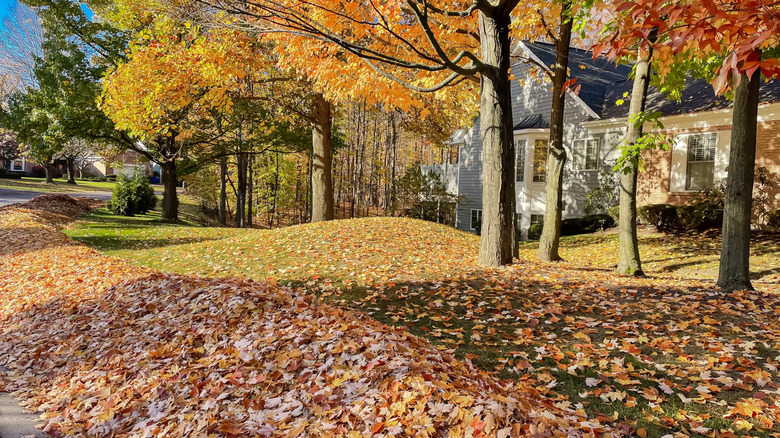Are There Too Many Fallen Leaves In Your Yard? Here's An Easy Way To Tell
The moment autumn arrives, leaves drift down like tiny memoirs from the trees, each one marking the passing of the season and painting your yard in shades of gold, amber, and rust. It's beautiful and almost magical, until you step outside and realize your once green yard is slowly disappearing beneath a crunchy carpet of debris. We love fall colors decorating our property, but there's a limit. If leaves cover more than 20% of your lawn and you can't even see the grass peeking through, that's your sign — you have too many leaves and need to take action.
Now, before you start raking the leaves in your yard, know that they aren't entirely the enemy. Leaving around 10% to 20% of coverage across your lawn is generally harmless and may, in fact, be a gift. While you can rake up and use fallen leaves to give garden soil an extra boost, you could also simplify matters and run them over with your mower, letting the chopped-up leaves act as mulch that gradually breaks down to nourish your yard. But when leaves pile up beyond that sweet spot and your grass disappears under the leafy blanket, trouble brews. Excess leaves may suffocate grass by blocking sunlight and air while creating damp conditions underneath that are perfect for fungal growth. Paying attention now will keep your lush lawn from becoming a hidden swamp of brown and injured grass.
What to do about excessive leaves in your yard
When your yard is buried under leaves, your first instinct is probably to rake it all up, bag it, and send it away. But what most of us don't know is that this quick fix ends up destroying habitats our local wildlife call home. Meanwhile, the EPA highlights that leaves and other yard debris make up around 12% of the nation's solid waste. Discarded leaves in landfills that don't get enough oxygen release methane, a greenhouse gas that impacts global warming much quicker than carbon dioxide. So, hauling them off isn't exactly saving the planet. What you could do instead is grab a mulching mower and chop those leaves into tiny pieces to create mulch that adds nutrients back to your soil. Even if half of your lawn is covered in leaves, mulching will break them down enough to expose more grass and get you under that 20% coverage threshold without requiring any raking and removal. You might just need to make a few passes to break them up so they fall past the grass blades.
If you have so many leaves (usually more than 50% coverage) that even mulching won't open up enough lawn, you'll have to remove and repurpose some. Prepare compost for your spring garden by mixing excess nutrient-rich leaves with green clippings and veggie scraps, or spread chopped leaves over garden beds to nourish the soil and keep weeds in check. Offer your extras to neighbors or local compost programs to turn your backyard problem into someone else's garden gold. There are also some creative ways to use fall leaves in your decor, like making a wreath or placing them in a vase. The possibilities are only limited by imagination!

